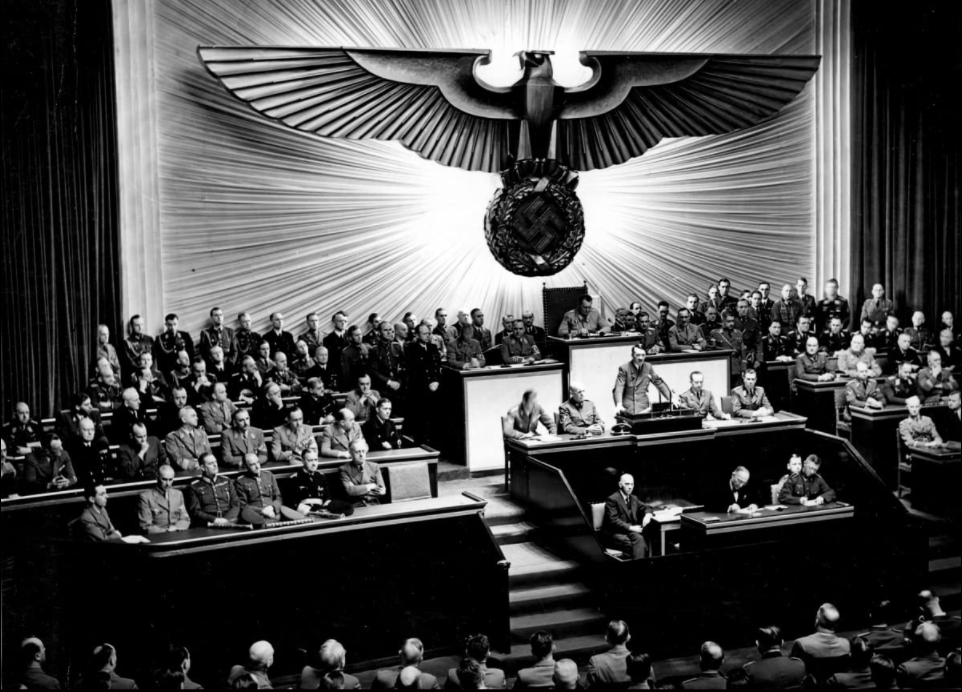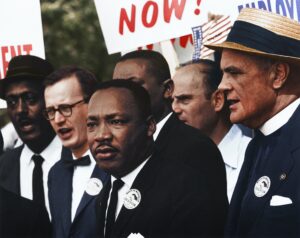“FASCISM logically results in the aestheticization of political life,” wrote Walter Benjamin in “The Work of Art in the Age of Its Technological Reproducibility.” English translations of this well-known essay have tended to obscure the expressive determinism of the German wording in this passage. For Benjamin, who had observed Hitler’s rise to power with a terrified gaze not unlike that of his own angel of history, fascism was both the pattern and engine through which political life “logically results”—or “runs out consequently” (läuft folgerecht hinaus)—into aestheticized formalizations. If we are to understand fascism as Benjamin did, we must examine its aesthetic function—that is, how fascism instills its own politicized ideals of truth, morality, purity, and beauty in those it calls together as subjects.
The political aesthetic of Mussolini’s fascism borrowed heavily from the patriarchal, militaristic pageantry of ancient Rome. But it was the Nazis who aspired to unify every aspect of creative and political life in a singular, totalizing gesture, and at whom Benjamin’s assessment seems implicitly aimed. Specifically, Benjamin’s poetic formulation of the aestheticization of politics held a mirror to the metaphysics of Nazi race ideology, in which the national soul was imagined to be the natural expression of the Nordic race. For the Nazis, the path to salvation necessitated the unification of the people into a single transcendent body (Volkskörper). Klaus Vondung has interpreted Nazism as a political religion fixated on the notion that only a grand, apocalyptic battle between the forces of light and darkness could “redeem” the German nation. The immediate cause of this need for “redemption” was the humiliation of World War I and the ineptitude of the Weimar Republic, but its roots extend back at least as far as Napoleon’s subjugation of the German states. In order to stage this apocalyptic battle, the Nazis first had to construct the combatants on both sides—the Volk in all its imagined purity and its polar opposite, exemplified in the antisemitic conception of the Jew.
Under the Nazi regime, the Volkskörper would be cultivated through a deliberate use of media and emotional spectacle. This tendency reached an apotheosis in Leni Riefenstahl’s film, Triumph of the Will, which was released in March of 1935 and may have elicited some of Benjamin’s observations in his oft-quoted essay. Riefenstahl fully exploited not only the moving image, but the newly realized auditory possibilities of sound film, blending footage from the 1934 Nazi Congress in Nuremberg with symphonic music and battle marches to construct a dazzling multimedia composition. The effect was utterly unlike anything that had ever been produced in the history of politics or cinema—in her famous essay on Riefenstahl, Susan Sontag called it “the most successfully, most purely propagandistic film ever made.”
To watch Triumph of the Will as a member of its target audience was to become utterly immersed in its audiovisual universe. While Hitler’s speeches are the film’s focal point, the visual impact of the human masses arranged along tight, straight aisles achieves a geometric unity that transcends the individual. Siegfried Kracauer compared these “mass ornaments” to the Tiller Girls, a troupe of dancers whose synchronous precision recalled the movements of workers on an assembly line. “Only as parts of a mass, not as individuals who believe themselves to be formed from within, do people become fractions of a figure,” Kracauer writes. In the Nazi spectacle of Triumph of the Will, a mythos of the masses and the industrial genealogy of the filmic image become one.
“When Marx undertook his critique of the capitalist mode of production, this mode of production was in its infancy,” Benjamin wrote. “Marx directed his efforts in such a way as to give them prognostic value.” Here, Benjamin invokes Marx’s architectonic metaphor of “base” (all the physical components of the means of production) and “superstructure” (the cultural and political systems dialectically engaged in the ongoing reproduction of the base): “Since the transformation of the superstructure proceeds far more slowly than that of the base, it has taken more than a half a century for the change in the conditions of production to be manifested in all areas of culture.” Just as Marx had theorized then-emerging modes of industrial production from the vantage point of the 19th century, Benjamin turned his attention to the ways that consciousness was being conditioned in his own time by the powerful new forms of media made possible by those modes of production.
For Benjamin, film—”the first art form whose artistic character is entirely determined by its reproducibility”—was emblematic of this cultural transformation and the new subjectivities it helped shape. Technically speaking, the methods for producing film had developed faster than the public’s ability to fully process what exactly had hit it. Although Riefenstahl claimed that her Nazi films captured “real events,” presenting them “without alteration,” the composition of Triumph of the Will reveals it to be a carefully staged simulacrum. It is not a film documenting a rally, but rather a filmic depiction of a rally-staged-for-film. Its strength as propaganda, however, depends on its audience’s willingness to believe that they are watching the former rather than the latter—a kind of slippage that Jean Baudrillard would later dub hyperreality.
The Thrill of Spectacle
At various times and places throughout history, potent new subjectivities have flourished in those periods when culture is playing catch-up to the implications of new media technologies, and Benjamin’s essay provides a brief survey of some of these moments. Of particular import to the historical development of Nazi ideology was the introduction of the printing press and moveable type to Germany in the mid 15th century — technologies that made printed discourse an industrially produced commodity for the first time in European history. The printing press is often credited with enabling a radical realignment of power that led to the Reformation and the Enlightenment. However, it also helped facilitate the viral spread of conspiratorial propaganda concerning blood libels and witch hunts.
It is crucial for the student of fascism to understand precisely how conspiratorial propaganda worked then, and continues to work now. The turn of the 16th century was a time of growing economic inequality in Europe, linked with the emergence of a wealthy new merchant class and new Italian banking techniques which facilitated international trade. The more conspicuous and concentrated this new wealth became, the more its beneficiaries—often working in league with both religious and secular authorities—sought strategies for deflecting anxiety and resentment away from themselves and onto ‘othered’ groups. The use of emerging mass media technologies to scapegoat Jews, alleged witches, and heretics—always anchored in an apocalyptic worldview that imagined European Christians as the ultimate protagonists of history—became an economically and theologically compelling strategy for reifying existing social and economic hierarchies, even as institutional structures were being dramatically realigned.
This scapegoating function served a dual purpose. Not only did it facilitate the concentration of wealth by deflecting economic and social anxieties away from the real causes of those concerns, it helped construct and strengthen the boundaries of a social body by marking those outside that body as ‘other.’ In his book Imagined Communities, Benedict Anderson traces the roots of modern nationalism to the society-shaping influence of vernacular literature that was widely available for the first time during the early decades of print capitalism. It is no coincidence that so many early printed publications served to foment resentment toward those perceived as outside the “imagined communities” being drawn together by these texts.
Just as comparisons may be productively drawn between the first decades of print capitalism and the emergence of radio and film, it is useful to think of our own political moment—saturated by social media and the emotional economy of clickbait—as another inflection point where technology’s affordances have developed faster than our ability to inoculate ourselves to their wiles. Over the past four years, many pixels have been spilled over whether Donald Trump may be compared to early twentieth-century fascists in general, and to Hitler in particular. In hindsight, it is clear that each man’s respective mastery of emerging media platforms—whether through overt institutional control or de facto, through the strategic implementation of shock—is one of the more compelling points of comparison. Like Hitler, Trump is a demagogue who saw the society-transforming potential in relatively new media paradigms and pushed them as far as they would take him.
Just as Hitler’s rise was abetted by an international climate of rising nationalism as well as the fears of bourgeois centrists at home, Trump’s rise was abetted not only by Republicans but also by liberals who ultimately found his brand of hypercapitalist nationalism less threatening than the socialist visions offered by the left. Joshua Briond has argued forcefully against the tendency to exceptionalize Trump, who (like Hitler) should be seen not as “the exception but the rule of what white-supremacist-patriarchal capitalism is capable of.” It could also be said that Trump has been useful to liberal centrists, insofar as he has provided a monstrous bogeyman against which their own imperialist, capitalist and racist violence can be made to seem less extreme by comparison.
In his 1995 essay “Ur-Fascism,” Umberto Eco noted fascism’s “appeal to a frustrated middle class.” (Trotsky made this point more pointedly when he identified the petite bourgeoisie as fascism’s consistent “base.”) “Economic anxiety” is often cited as a precursor for fascism, but fascism does not offer an antidote to poverty and dispossession. Instead, it offers a rationalization for the existence of poverty that defuses demands for redress, blaming the suffering brought about by capitalist policy on hated groups rather than on the actions of those who are directly profiting off poverty. This familiar function—of fostering a false, aspirational identification with the wealthy, while deflecting anxiety away from those who are concretely responsible for suffering onto scapegoats—is central to fascism’s usefulness to status quo maintenance.
“The masses have a right to changed property relations,” wrote Benjamin. “Fascism seeks to give them expression in keeping these relations unchanged.” In lieu of a redistribution of wealth, fascism offers an emotionally thrilling spectacle, justifying and strengthening the power of the ruling classes while also neutralizing the power of the masses as revolutionary agents. Those who internalize its ideology exchange their actual political, social, and spiritual potential for an artificially constructed solidarity with the already-powerful, who actually care nothing about them and have no intention of sharing their power. The balance is paid by those against whom violence has been sanctioned.
Fascisms Present and Impending
On January 20th, 2021, many people all over the world issued a collective sigh of relief at the end of Trump’s presidency. America had survived its brush with fascism, the narrative went. But was Trump what made America fascist? Or was Trump merely a manifestation of what has always lurked in the shadows of the American system, waiting for someone to say the quiet part loud? According to Pete Seeger, Woody Guthrie said that fascism is when “the rich people get the generals to help them stay in control”; Aimé Césaire noted that what we call fascism occurs when white people are subjected to what enslaved and colonized populations are routinely subjected to. By both of these measures, fascism has always been as American as Jim Crow and genocide.
Due in part to the grim, industrial efficiency with which they carried out their genocide, the Nazis have become the benchmark by which all other fascisms tend to be measured. But there is a danger in identifying fascism as “fascism” only when it has reached its most extreme form. In practice, fascism is a spectrum of tendencies and actions aimed at normalizing and justifying what ultimately amounts to a kind of necropolitics: the idea that some individuals are more worthy of the basic means of survival than others. It is this spectrum that Michel Foucault meant when he exalted “the art of living counter to all forms of fascism, whether already present or impending.”
The deepest seed of fascism lies neither in the cult of dictator nor in political apocalypticism but in the basic functioning of the capitalist system, which must justify its cutthroat logic by convincing its subjects that depriving human beings of food, shelter, freedom, and even life for profit is not only ethical, but natural. This germinal fascism must be seen not as the opposite of bourgeois liberal democracy, but as a latent possibility within it. At the core of liberalism is an irreducible tension between political freedom and economic freedom. When these two ideals clash, the ruling classes are always content to allow the demands of capital to overrule calls for equality. Fascism provides an ideological framework that allows the demands of capital to override the demands for political freedom with impunity.
One of the most thoroughly and unambiguously fascist spectacles to emerge from the US over the last four years had nothing to do with Trump. It is the 2019 documentary Seattle Is Dying, produced for the Sinclair-owned Seattle “news” channel KOMO. Seattle Is Dying presents a voyeuristic montage of people on the streets of Seattle in varying states of crisis. These individuals are described by the snarling voice of the narrator as “lost souls, consumed by demons.” In a series of carefully curated interviews, local business owners, tourists, and police officers express dismay—not at the runaway capitalism that has brought the city’s visible poverty to a breaking point, but that the individuals living on the streets are not being further punished for having their crises in broad daylight. The solution repeatedly prescribed by this hour-long “special report” is to strengthen the power of the police to criminalize homelessness and addiction. Whether or not the similarity is intentional, the editorial style of Seattle Is Dying is reminiscent of the 1940 Nazi film The Eternal Jew, which used footage shot in the ghettoes of Nazi-occupied Poland to portray their inhabitants as filthy and uncivilized. Critics of this antisemitic documentary have correctedly pointed out that the poverty portrayed was in fact the result of Nazi policy. But accuracy is not the point of The Eternal Jew. It is pure propaganda designed to arouse strong emotions like hatred and disgust.
The premise of Seattle Is Dying is absurd on the surface: while the documentary was being made, Seattle was among the fastest-growing cities in the US, due largely to the rapid expansion of Amazon. Conspicuously absent from the report is any mention of the tech giant’s role in fighting public initiatives to tax corporations in order to fund affordable housing, nor of the many groups advocating for community services that do not involve criminalizing homelessness. Causality is ignored in favor of an emotionalized spectacle explicitly designed to foment resentment toward the unhoused. At one point, the narrator describes the city as a “beautiful jewel that has been violated” by those who have the audacity to be poor in public.
Living “Counter to All Forms of Fascism”
The historian Brian Winston has argued that there’s no such thing as fascist aesthetics as an independent category, but that mainstream Western aesthetics can be, “on occasion, fascist.” This is a cheeky way of saying that the distinctive mode of formalizing hierarchical relationships that we recognize as “fascist aesthetics” has deep roots in the formation of what is often called Western civilization. These roots correspond to a history of physical and economic domination, subjugation, and empire-building. In ancient Rome, monumental sculpture represented the conquest of subordinated provinces in gendered terms—the empire was always equated with masculinity and strength, while conquered peoples were portrayed as feminized and weak. Such conventions serve the ideological purpose, in the words of Natalie Boymel Kampen, of reproducing “social arrangements” in a way that makes them “seem completely natural, so inevitable and universal that they couldn’t possibly need any help at all.” In the early 20th century, Mussolini took a large, lavishly illustrated page from the ancient Roman imperial playbook. The Nazi concept of the Third Reich, meanwhile, aimed to establish a lineage connecting Hitler’s government with previous instantiations of imperial rule in Germany, extending back to the reign of Charlemagne.
In the 21st century, fascist aesthetics are often more subtle. While it’s easy to point to the fascist aesthetics at a Trump rally, it can be a bit trickier to parse propaganda when it’s oozing from the nightly news. Broadly speaking, the fascist aesthetic is concerned with the ongoing production and weaponization of the boundary between those who are imagined to deserve basic human rights and those who do not, for the benefit of those who profit from depriving individuals of those rights. Thus, the dominant aesthetics of white supremacist patriarchal capitalism are always already fascist insofar as they idealize bodies that are optimized to reproduce the structures of capital and seek to control those bodies and their production. Under this system, the queer, disabled, or addicted body is characterized as loathsome precisely because it resists being utterly defined by the forces of capital. Behind each of these mythic constructions—both the idealized and the degenerate—is a quasi-Darwinian fantasy that they are the embodiment of eternal moral categories.
The backdrop and fertile soil for the current proliferation of fascist ideology is the COVID-19 pandemic, which has exacerbated poverty and precarity for many Americans, widening disparities along racialized lines while billionaires have profited exponentially. Under any reasonable political outlook, this would provoke a drastic reassessment of the systems that allow such violent inequality to go unchecked. But fascist ideology devastates our ability to advocate for the humane treatment of those forsaken by capitalism. It allows us to rationalize away moral abominations by imagining that the poor are not only responsible for their fate, but deserve to be punished by the carceral state. The ideology of “law and order,” which has strong advocates in both of the US’s major political parties, exists to enforce violently unequal power relations.
As Benjamin reminds us, the masses have a right to changed property relations. Our various diversions can therefore be construed as fascist insofar as they offer us an outlet of expression which keeps these relations fundamentally unchanged. Another threat, more devastating than the pandemic, is waiting in the wings. It is the global climate catastrophe brought on by decades of complicity between governments and the fossil fuel industry, which will wreak untold havoc before the end of this century. The current rise of fascist and ultra-nationalist movements anticipates an impending wave of climate refugees as vast swaths of the planet’s surface become unable to support human life. As the systems of capitalism reveal themselves to be untenable, the fascist impulse will be to double down rather than divest.
What is needed now, in order to live “counter to all forms of fascism,” is an honest assessment, not only of the ways in which many of the systems we take for granted enabled Trump, but of how these systems will continue to enable an imperialist foreign policy, a domestic police state, the suppression of democracy, and the rise of more capable would-be authoritarians in his absence. We must be critical of our own tendency to measure human worth in terms of capacity for industry, and skeptical of schemas that rationalize a lack of access to the basic means of survival for any member of our human community.
One ancient model for this kind of anti-fascist living may be found in the Acts of the Apostles where each believer is said to have contributed “according to their ability” (11:29) and accepted “according to their need” (4:35). In his 1921 fragment “Capitalism as Religion,” Benjamin describes capitalism as a parasite that has developed on Christianity in the West. The disparity between the organization of the early church and the political convictions of many who call themselves Christians today demonstrates how difficult it has become to tell where the host ends and the parasite begins. The social organization described in the Acts of the Apostles (later echoed by Marx in his formulation of the communist ideal) is not merely ethical. It is pragmatic because a social program that tends to a community’s basic needs is foundational for the empowerment of that community. This organizational pragmatism can be found in the Black Panther Party’s free breakfast program, and in the many mutual aid networks that have sprung up in response to the COVID-19 pandemic. Capitalist systems achieve their unequal power differential by depriving individuals of the basic means of survival; building power through solidarity, both inside and outside the state apparatus, is one of the most potent tactics we have at our disposal for countering this disparity.
“Like its progenitor, capitalism, fascism is totally opposed to socialism,” wrote Walter Rodney in 1972. Fascism undermines the possibility of socialist solidarity and policy by making its subjects feel resentful that people who do not “deserve” aid might receive it anyway. This antipathy is often so strong that individuals will oppose policies that will help their own communities if it means that hated groups will also benefit. This mechanism is a tremendous obstacle to solidarity and empowerment, and that’s the point of cultivating it. The weaponized boundaries that fascism places around its politicized, hierarchical ideals are fetters on the social imagination which limit our ability to imagine equitable, sustainable, and humane alternatives to the capitalist order.
Fascism exploits a collectivist tendency—the human desire to be a part of something larger than oneself. But instead of class consciousness, fascism provides a violent paradigm that only serves to further entrench the ruling class. In order to free ourselves from this paradigm, collectivist desire must be met with real collectivist action.
Emily Pothast is an artist, musician, and historian of art and religion. She holds an MFA from the University of Washington and is a PhD student at Graduate Theological Union. Her writing has appeared in The Wire, Art In America, and Hyperallergic.




